Assessing Evidence for Weather Regimes Governing Solar Power Generation in Kuwait
Abstract
:1. Introduction
2. Data and Methods
2.1. Data
2.2. Method
2.2.1. Clearness Index
2.2.2. Mixture Distributions
3. Exploratory Evidence
4. Results
4.1. Mixture Models
4.2. Identification of Synoptic Weather Conditions
5. Discussion and Conclusions
Author Contributions
Funding
Acknowledgments
Conflicts of Interest
References
- Haupt, S.E.; Kosovic, B.; Jensen, T.; Lazo, J.; Lee, J.; Jimenz, P.; Cowie, J.; Wiener, G.; McCandless, T.; Rogers, M.; et al. Building the Sun4Cast system: Improvements in solar power forecasting. Bull. Am. Meteorol. Soc. 2018, 121–135. [Google Scholar] [CrossRef]
- Lohmann, G. Irradiance variability quantification and small-scale averaging in space and time: A short review. Atmosphere 2018, 9, 264. [Google Scholar] [CrossRef]
- Reikard, G.; Haupt, S.E.; Jensen, T. Forecasting ground-level irradiance over short horizons: Meteorological and time series models. Renew. Energy 2017, 112, 474–485. [Google Scholar] [CrossRef]
- Van der Meer, D.W.; Widén, J.; Munkhammar, J. Review on probabilistic forecasting of photovoltaic power production and electricity consumption. Renew. Sustain. Energy Rev. 2018, 81, 1484. [Google Scholar] [CrossRef]
- Bracale, A.; De Falco, P. An advanced bayesian method for short-term probabilistic forecasting of the generation of wind power. Energies 2015, 8, 10293–10314. [Google Scholar] [CrossRef]
- Diagne, M.; David, M.; Lauret, P.; Boland, J.; Schmutz, N. Review of solar irradiance forecasting methods and a proposition for small-scale insular grids. Renew. Sustain. Energy Rev. 2013, 27, 65–76. [Google Scholar] [CrossRef]
- Clack, C.T.M. Modeling solar irradiance and solar pv power output to create a resource assessment using linear multiple multivariate regression. J. Appl. Meteorol. Climatol. 2017, 56, 109–125. [Google Scholar] [CrossRef]
- Deshmukh, M.K.; Deshmukh, S.S. Modeling of hybrid renewable energy systems. Renew. Sustain. Energy Rev. 2008, 12, 235–249. [Google Scholar] [CrossRef]
- Auligné, T. Multivariate minimum residual method for cloud retrieval. Part I: Theoretical aspects and simulated observations experiments. Mon. Weather Rev. 2014. [Google Scholar] [CrossRef]
- Auligné, T. Multivariate minimum residual method for cloud retrieval. Part II: Real observations experiments. Mon. Weather Rev. 2014. [Google Scholar] [CrossRef]
- Jimenez, P.A.; Hacker, J.P.; Dudhia, J.; Haupt, S.E.; Ruiz-Arias, J.A.; Gueymard, C.A.; Deng, A. WRF-Solar: Description and clear-sky assessment of an augmented NWP model for solar power prediction. Bull. Am. Meteorol. Soc. 2016, 97, 1249. [Google Scholar] [CrossRef]
- Greybush, S.J.; Haupt, S.E.; Young, G.S. The regime dependence of optimally weighted ensemble model consensus forecasts of surface temperature. Weather Forecast. 2008, 23, 1146. [Google Scholar] [CrossRef]
- Lai, C.S.; Jia, Y.; McCulloch, M.D.; Xu, Z. Daily clearness index profiles cluster analysis for photovoltaic system. IEEE Trans. Ind. Inf. 2017, 13, 2322. [Google Scholar] [CrossRef]
- Lorenz, E.; Hammer, A. Short term forecasting of solar radiation based on satellite data. In Proceedings of the EUROSUN2004, Freiburg, Germany, 20–23 June 2004. [Google Scholar]
- Mellit, A.; Massi Pavan, A.; Lughi, V. Short-Term forecasting of power production in a large-scale photovoltaic plant. Sol. Energy 2014, 105, 401–413. [Google Scholar] [CrossRef]
- Hocaoglu, F.O.; Serttas, F. A novel hybrid (Mycielski-Markov) model for hourly solar radiation forecasting. Renew. Energy 2017, 108, 635–643. [Google Scholar] [CrossRef]
- McCandless, T.C.; Haupt, S.E.; Young, G.S. A regime-dependent artificial neural network technique for short-range solar irradiance forecasting. Renew. Energy 2016, 89, 351–359. [Google Scholar] [CrossRef]
- Morf, H. Sunshine and cloud cover prediction based on Markov processes. Sol. Energy 2014, 110, 615–626. [Google Scholar] [CrossRef]
- Poggi, P.; Notton, G.; Muselli, M.; Louche, A. Stochastic study of hourly total solar radiation in Corsica using a Markov model. Int. J. Climatol. 2000, 20, 1843–1860. [Google Scholar] [CrossRef]
- Frimane, Â.; Aggour, M.; Ouhammou, B.; Bahmad, L. A Dirichlet-multinomial mixture model-based approach for daily solar radiation classification. Sol. Energy 2018, 171, 31–39. [Google Scholar] [CrossRef]
- Munkhammar, J.; Widén, J. A Markov-chain probability distribution mixture approach to the clear-sky index. Sol. Energy 2018, 170, 174–183. [Google Scholar] [CrossRef]
- Ailliot, P.; Monbet, V. Markov-Switching autoregressive models for wind time series. Environ. Modell. Softw. 2012, 30, 92–101. [Google Scholar] [CrossRef]
- Carta, J.A.; Ramírez, P. Use of finite mixture distribution models in the analysis of wind energy in the Canarian Archipelago. Energy Convers. Manag. 2007, 48, 281–291. [Google Scholar] [CrossRef]
- Zhang, J.; Chowdhury, S.; Messac, A.; Castillo, L. A Multivariate and multimodal wind distribution model. Renew. Energy 2013, 51, 436–447. [Google Scholar] [CrossRef]
- Inman, R.H.; Pedro, H.T.C.; Coimbra, C.F.M. Solar forecasting methods for renewable energy integration. Prog. Energy Combust. Sci. 2013, 39, 535–576. [Google Scholar] [CrossRef]
- Zucchini, W.; MacDonald, I.L. Hidden Markov Models for Time Series: An Introduction Using R; CRC Press: Boca Raton, FL, USA, 2009. [Google Scholar]
- Hughes, J.P.; Guttorp, P. A class of stochastic models for relating synoptic atmospheric patterns to regional hydrologic phenomena. Water Resour. Res. 1994. [Google Scholar] [CrossRef]
- Bellone, E.; Hughes, J.P.; Guttorp, P. A hidden Markov model for downscaling synoptic atmospheric patterns to precipitation amounts. Clim. Res. 2000, 4415, 15. [Google Scholar] [CrossRef]
- Carey-Smith, T.; Sansom, J.; Thomson, P. A hidden seasonal switching model for multisite daily rainfall. Water Resour. Res. 2014, 50, 257–272. [Google Scholar] [CrossRef]
- Ghahramani, Z. An introduction to hidden models and bayesian networks. Int. J. Pattern Recognit. Artif. Intell. 2001, 15, 9–42. [Google Scholar] [CrossRef]
- Bessac, J.; Ailliot, P.; Cattiaux, J.; Monbet, V. Comparison of hidden and observed regime-switching autoregressive models for (u, v)-components of wind fields in the northeastern Atlantic. Adv. Stat. Climatol. Meteorol. Oceanogr. 2016, 2, 1–16. [Google Scholar] [CrossRef]
- Soubdhan, T.; Emilion, R.; Calif, R. Classification of daily solar radiation distributions using a mixture of Dirichlet distributions. Sol. Energy 2009, 83, 1056. [Google Scholar] [CrossRef]
- Béranger, B.; Duong, T.; Perkins-Kirkpatrick, S.E.; Sisson, S.A. Tail density estimation for exploratory data analysis using kernel methods. J. Nonparametric Stat. 2019, 31, 144–174. [Google Scholar] [CrossRef]
- Fernández-Peruchena, C.M.; Bernardos, A. A comparison of one-minute probability density distributions of global horizontal solar irradiance conditioned to the optical air mass and hourly averages in different climate zones. Sol. Energy 2015, 112, 425–436. [Google Scholar] [CrossRef]
- Jurado, M.; Caridad, J.M.; Ruiz, V. Statistical distribution of the clearness index with radiation data integrated over five minute intervals. Sol. Energy 1995, 55, 469–473. [Google Scholar] [CrossRef]
- Tabone, M.D.; Callaway, D.S. Modeling variability and uncertainty of photovoltaic generation: A hidden state spatial statistical approach. IEEE Trans. Power Syst. 2015, 30, 2965. [Google Scholar] [CrossRef]
- Ngoko, B.O.; Sugihara, H.; Funaki, T. Synthetic generation of high temporal resolution solar radiation data using Markov models. Sol. Energy 2014, 103, 160–170. [Google Scholar] [CrossRef]
- Alimohammadi, S.; He, D. Multi-Stage algorithm for uncertainty analysis of solar power forecasting. In Proceedings of the 2016 IEEE Power Energy Society General Meeting (PESGM), Boston, MA, USA, 17–21 July 2016; pp. 1–5. [Google Scholar] [CrossRef]
- Köhler, C.; Steiner, A.; Saint-Drenan, Y.-M.; Ernst, D.; Bergmann-Dick, A.; Zirkelbach, M.; Ritter, B. Critical weather situations for renewable energies—Part B: Low stratus risk for solar power. Renew. Energy 2017, 101, 794–803. [Google Scholar] [CrossRef]
- Rodríguez-Benítez, F.J.; Arbizu-Barrena, C.; Santos-Alamillos, F.J.; Tovar-Pescador, J.; Pozo-Vázquez, D. Analysis of the intra-day solar resource variability in the Iberian Peninsula. Sol. Energy 2018, 171, 374–387. [Google Scholar] [CrossRef]
- Ailliot, P.; Bessac, J.; Monbet, V.; Pène, F. Non-Homogeneous hidden Markov-switching models for wind time series. J. Stat. Plann. Inference 2015, 160, 75–88. [Google Scholar] [CrossRef] [Green Version]
- Menne, M.J.; Durre, I.; Korzeniewski, B.; McNeal, S.; Thomas, K.; Yin, X.; Houston, T.G. Global Historical Climatology Network—Daily (GHCN-Daily), Version 3.24; NOAA National Climatic Data Center: Asheville, NC, USA, 2018. [Google Scholar] [CrossRef]
- Menne, M.J.; Durre, I.; Vose, R.S.; Gleason, B.E.; Houston, T.G. An Overview of the Global Historical Climatology Network-Daily Database. J. Atmos. Ocean. Technol. 2012, 29, 897–910. [Google Scholar] [CrossRef]
- NOAA NCEI CDO. Integrated Surface Data, DS3505, NOAA National Centers for Environmental Information Climate Data Online. Available online: www.cdo.NCEI.noaa.gov (accessed on 18 April 2018).
- Qu, Z.; Oumbe, A.; Blanc, P.; Espinar, B.; Gesell, G.; Gschwind, B.; Wald, L. Fast radiative transfer parameterisation for assessing the surface solar irradiance: The Heliosat-4 method. Meteorologische Zeitschrift 2017, 26, 33–57. [Google Scholar] [CrossRef]
- Lefèvre, M.; Oumbe, A.; Blanc, P.; Espinar, B.; Gschwind, B.; Qu, Z.; Morcrette, J.-J. McClear: A new model estimating downwelling solar radiation at ground level in clear-sky conditions. Atmos. Meas. Tech. 2013, 6, 2403. [Google Scholar] [CrossRef] [Green Version]
- Dee, D.P.; Uppala, S.M.; Simmons, A.J.; Berrisford, P.; Poli, P.; Kobayashi, S.; Vitart, F. The ERA-Interim reanalysis: Configuration and performance of the data assimilation system. Quart. J. Roy. Meteorol. Soc. 2011, 137, 553–597. [Google Scholar] [CrossRef]
- Liu, B.Y.H.; Jordan, R.C. The interrelationship and characteristic distribution of direct 2418, diffuse and total solar radiation. Sol. Energy 1960, 4, 1–19. [Google Scholar] [CrossRef]
- Nemes, C.; Ciobanu, R.; Rugina, C. Probabilistic analysis of Sky clearness index for solar energy systems planning. In Proceedings of the 2018 Smart City Symposium Prague (SCSP), Prague, Czech Republic, 24–25 May 2018; pp. 1–9. [Google Scholar] [CrossRef]
- Wilks, D.S. Statistical Methods in the Atmospheric Sciences, 3rd ed.; Academic Press Inc.: Waltham, MA, USA, 2011. [Google Scholar]
- Dempster, A.P.; Laird, N.M.; Rubin, D.B. Maximum likelihood from incomplete data via the EM algorithm. J. Roy. Stat. Soc. Ser. B Methodol. 1977, 39, 1–38. [Google Scholar]
- Do, C.B.; Batzoglou, S. What is the expectation maximization algorithm? Nat. Biotechnol. 2008, 26, 897–899. [Google Scholar] [CrossRef] [PubMed]
- R Core Team. A Language and Environment for Statistical Computing. R Foundation for Statistical Computing: Vienna, Austria, 2018. Available online: http://www.r-project.org/ (accessed on 28 December 2018).
- Benaglia, T.; Chauveau, D.; Hunter, D.R.; Young, D. Mixtools: An R package for analyzing finite mixture models. J. Stat. Softw. 2009, 32, 1–29. [Google Scholar] [CrossRef] [Green Version]
- Akaike, H. A new look at the statistical model identification. IEEE Trans. Autom. Control 1974, 19, 716–723. [Google Scholar] [CrossRef]
- Hinkelman, L.M.; Schaeffer, N. Relating solar resource and its variability to weather and climate across the northwestern United States. Sol. Energy 2017, 157, 966–978. [Google Scholar] [CrossRef]
- Nasrallah, H.A.; Balling, R.C.; Selover, N.J.; Vose, R.S. Development of a seasonal forecast model for Kuwait winter precipitation. J. Arid Environ. 2001, 48, 233–242. [Google Scholar] [CrossRef]
- Aldababseh, A.; Temimi, M. Analysis of the long-term variability of poor visibility events in the UAE and the link with climate dynamics. Atmosphere 2017, 8, 242. [Google Scholar] [CrossRef] [Green Version]
- Naizghi, M.S.; Ouarda, T.B.M.J. Teleconnections and analysis of long-term wind speed variability in the UAE. Int. J. Climatol. 2017, 37, 230–248. [Google Scholar] [CrossRef]
- Naegele, S.M.; McCandless, T.C.; Greybush, S.J.; Young, G.S.; Haupt, S.E.; Al-Rasheedi, M. Climatology of wind variability for the Kuwait Region. Renew. Energy 2019, in press. [Google Scholar]
- Peyvandi, S.; Amirshahi, S.H.; Hernández-Andrés, J.; Nieves, J.L.; Romero, J. Spectral recovery of outdoor illumination by an extension of the Bayesian inverse approach to the Gaussian mixture model. J. Opt. Soc. Am. A 2012, 29. [Google Scholar] [CrossRef] [PubMed]
- Almazroui, M.; Dambul, R.; Islam, M.N.; Jones, P.D. Atmospheric circulation patterns in the Arab region and its relationships with Saudi Arabian surface climate: A preliminary assessment. Atmos. Res. 2015, 161, 36–51. [Google Scholar] [CrossRef]
- El Kenawy, A.M.; McCabe, M.F.; Stenchikov, G.L.; Raj, J. Multi-Decadal classification of synoptic weather types, observed trends and links to rainfall characteristics over Saudi Arabia. Front. Environ. Sci. 2014, 2. [Google Scholar] [CrossRef] [Green Version]
- Houssos, E.E.; Chronis, T.; Fotiadi, A.; Hossain, F. Atmospheric circulation characteristics favoring dust outbreaks over the solar village, central Saudi Arabia. Mon. Weather Rev. 2015, 143, 3263. [Google Scholar] [CrossRef]
- Alobaidi, M.; Almazroui, M.; Mashat, A.; Jones, P.D. Arabian Peninsula wet season dust storm distribution: Regionalization and trends analysis (1983–2013). Int. J. Climatol. 2017, 37, 1356. [Google Scholar] [CrossRef]
- Ouarda, T.B.M.J.; Charron, C.; Shin, J.-Y.; Marpu, P.R.; Al-Mandoos, A.H.; Al-Tamimi, M.H.; Al Hosary, T.N. Probability distributions of wind speed in the UAE. Energy Convers. Manag. 2015, 93, 414–434. [Google Scholar] [CrossRef] [Green Version]
- Lamb, H.H. British Isles weather types and a register of daily sequence of circulation patterns. In 1861–1971: Geophysical Memoir; HMSO: London, UK, 1972; Volume 116, p. 85. [Google Scholar]
- World Energy Outlook 2018. Available online: http://www.iea.org/weo/ (accessed on 17 July 2019).
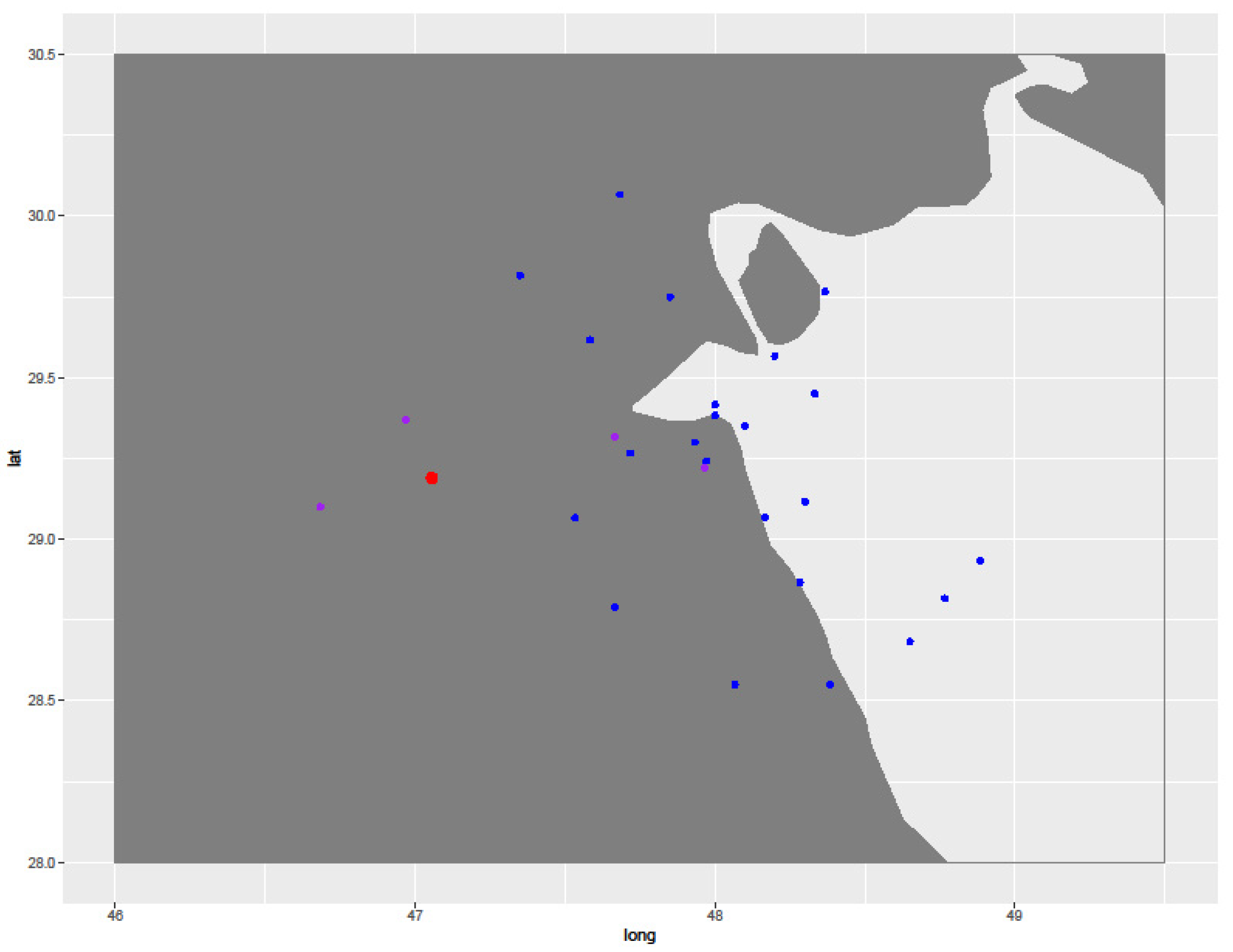
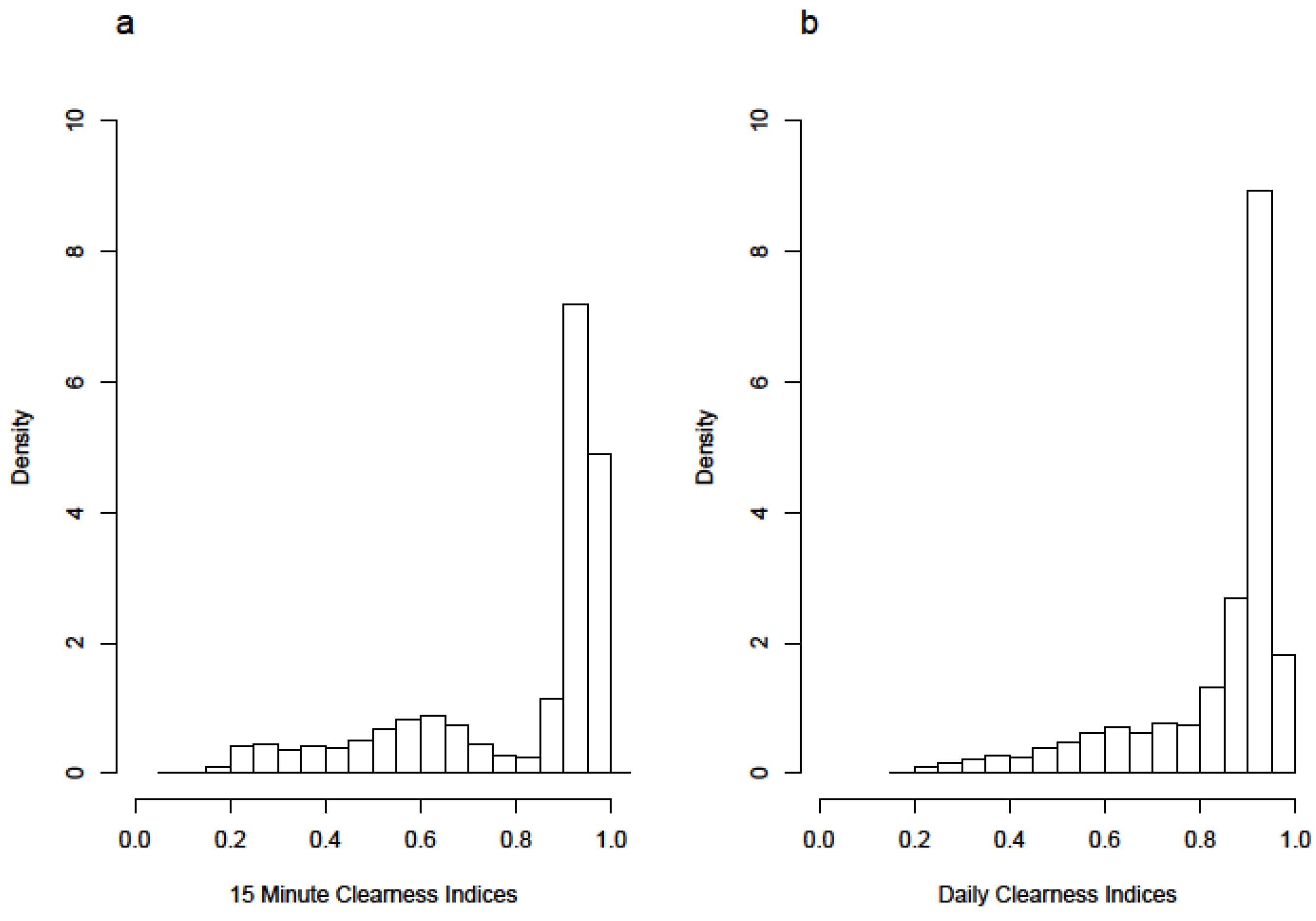
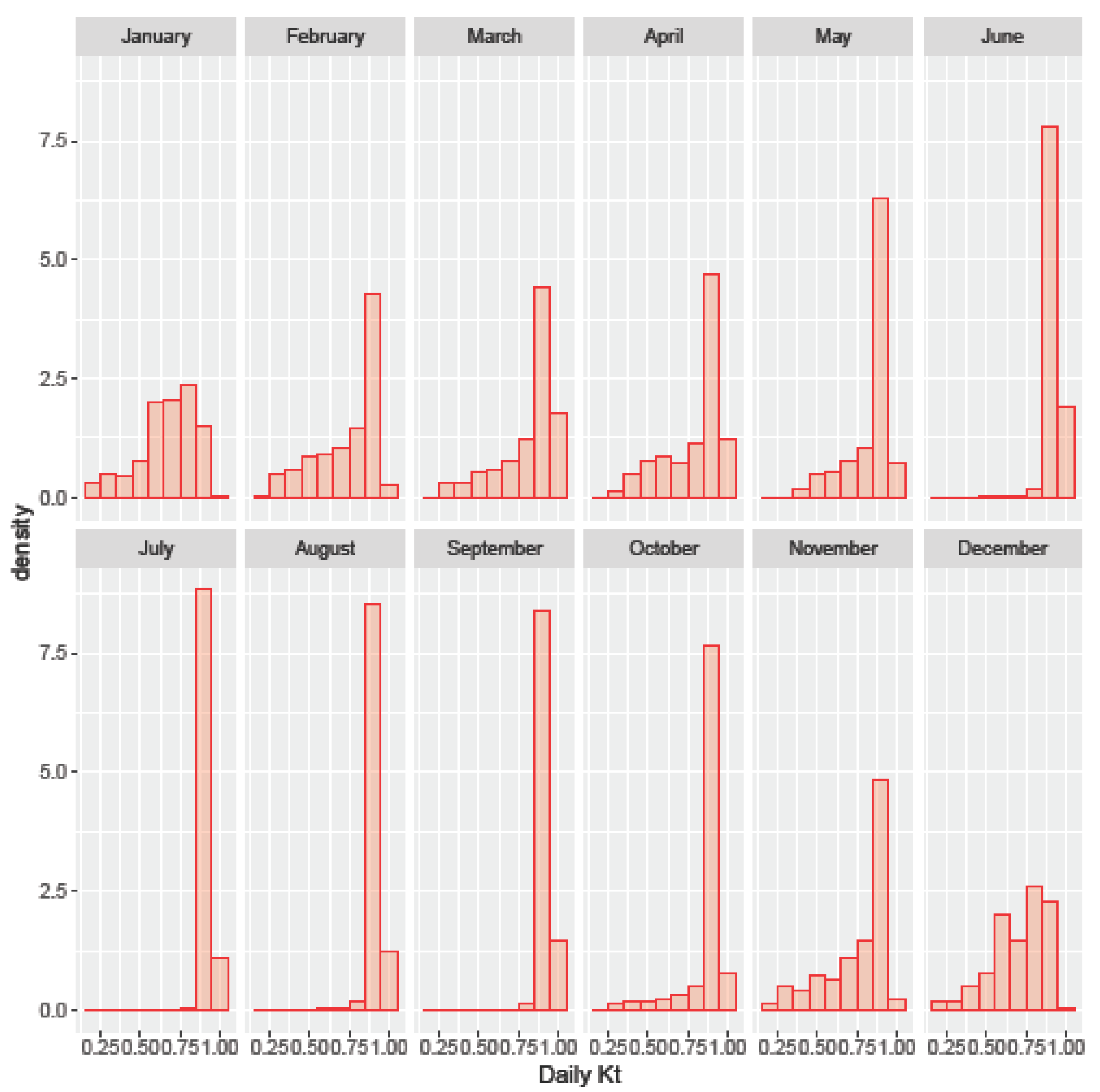
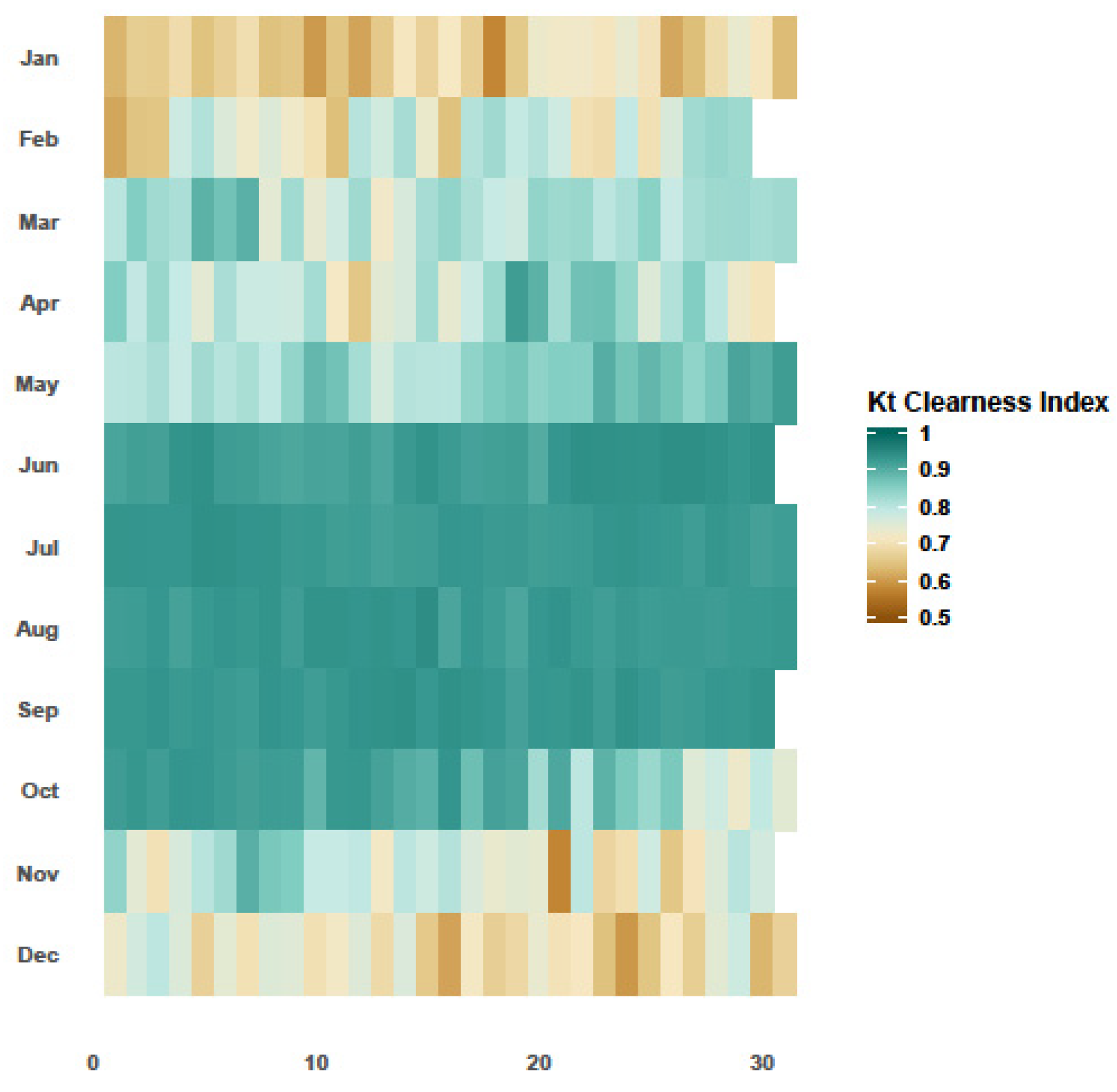

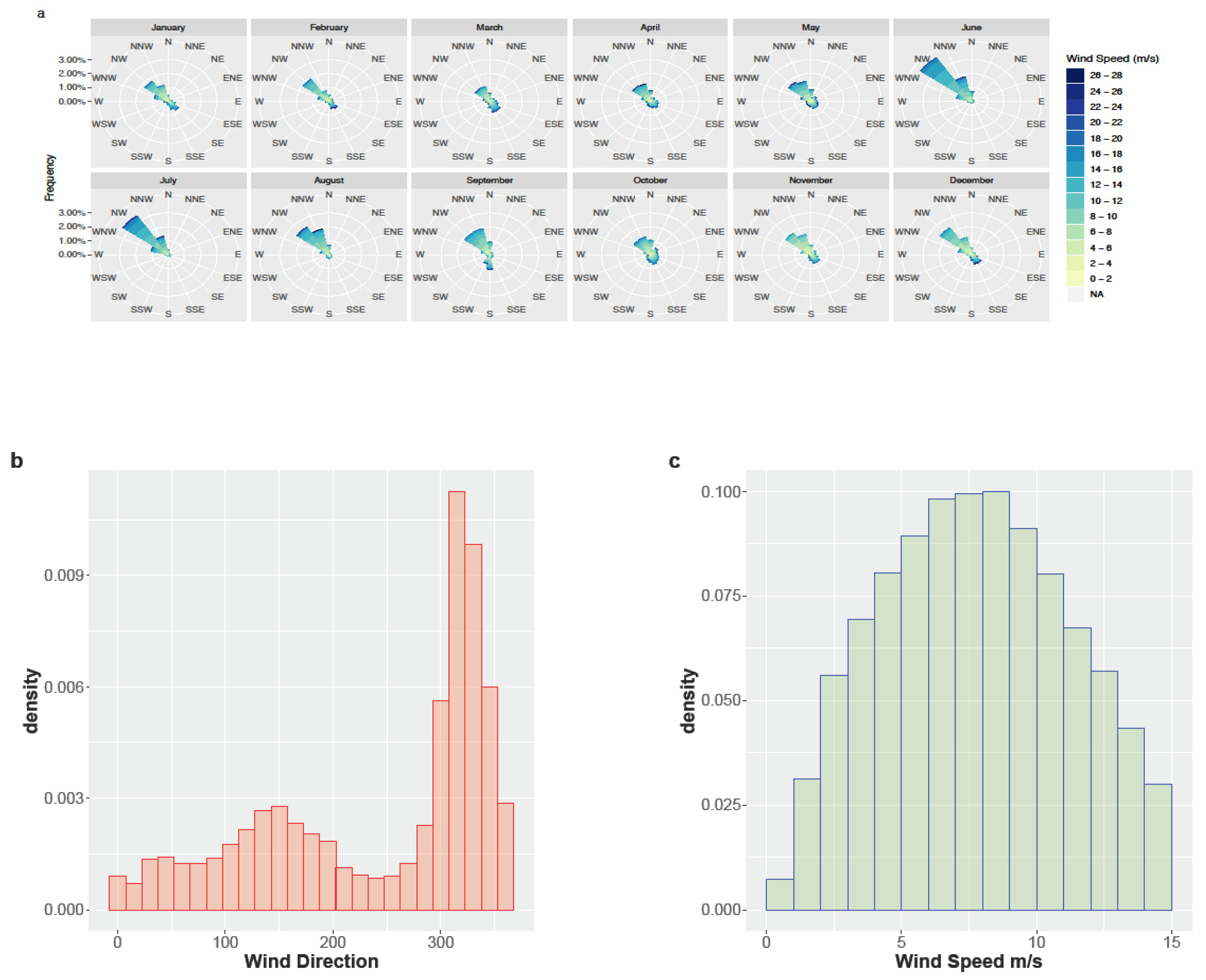




© 2019 by the authors. Licensee MDPI, Basel, Switzerland. This article is an open access article distributed under the terms and conditions of the Creative Commons Attribution (CC BY) license (http://creativecommons.org/licenses/by/4.0/).
Share and Cite
Tye, M.R.; Haupt, S.E.; Gilleland, E.; Kalb, C.; Jensen, T. Assessing Evidence for Weather Regimes Governing Solar Power Generation in Kuwait. Energies 2019, 12, 4409. https://doi.org/10.3390/en12234409
Tye MR, Haupt SE, Gilleland E, Kalb C, Jensen T. Assessing Evidence for Weather Regimes Governing Solar Power Generation in Kuwait. Energies. 2019; 12(23):4409. https://doi.org/10.3390/en12234409
Chicago/Turabian StyleTye, Mari R., Sue Ellen Haupt, Eric Gilleland, Christina Kalb, and Tara Jensen. 2019. "Assessing Evidence for Weather Regimes Governing Solar Power Generation in Kuwait" Energies 12, no. 23: 4409. https://doi.org/10.3390/en12234409




